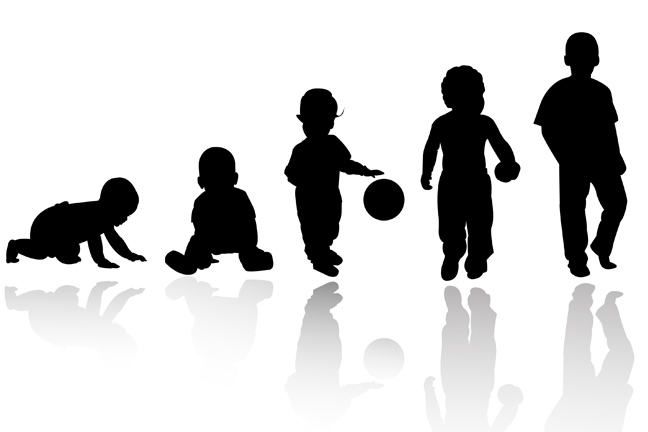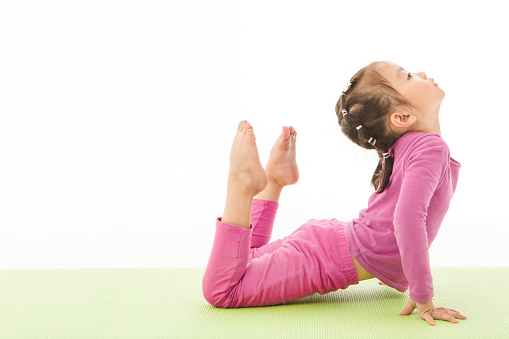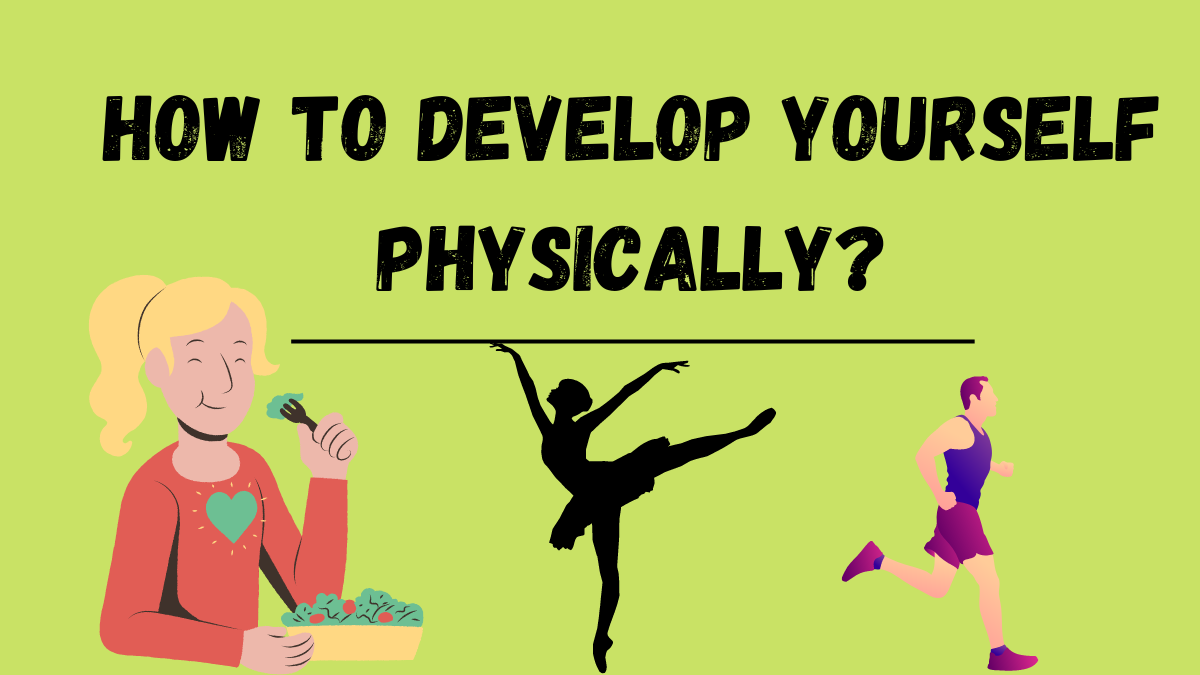Contents
What is Physical Development?
Physical development entails the process of nurturing your physique or enhancing your bodily capabilities. Engaging in self-improvement endeavors yields numerous advantages. The merits of physical development encompass fortifying your skeletal structure, enhancing your emotional well-being, fostering increased vitality, and more. The significance of cultivating your physical self cannot be overstated.
Multiple avenues exist to embark upon the journey of self-physical development. Allow me to present a selection of the most commendable approaches through which you can foster personal growth in the realm of physicality.
4 Best Ways To Develop Yourself Physically:
- Walk outdoors every day.
- Eat healthy food.
- Dance.
- Get better sleep.
1. Walk Outdoors Every Day

Embarking on a brisk morning stroll stands as the ultimate endeavor for nurturing your physical self. This invigorating activity not only tranquilizes the mind but also serves as a catalyst for augmenting cognitive prowess and sustaining overall vitality. Moreover, a refreshing morning walk kindles a perpetual sense of buoyancy, infusing each day with a renewed zest. Its transformative effects extend to fat burning and weight management, further enhancing your physical well-being.
The therapeutic benefits of morning walking extend beyond mere fitness. This enchanting practice effectively safeguards against a myriad of ailments, including the regulation of blood pressure, mitigating the risk of heart attacks, calming your mind, fortifying defenses against lung cancer, and much more.
Benefits of Morning Walk:
- Boosts physical fitness and endurance.
- Enhances mental clarity and reduces stress.
- Improves mood and increases energy levels.
- Supports weight management efforts.
- Promotes heart health and maintains healthy blood pressure levels.
- Contributes to an overall sense of well-being.
- Aids in stress reduction and promotes better sleep quality.
- Enhances immune function and strengthens the body’s defenses.
- Provides an opportunity for fresh air and a connection with nature.
- Sets a positive tone for the day and increases productivity.
2. Eat Healthy Food

Consuming a nutritious diet plays a pivotal role in fostering physical development. Here are some key aspects to consider when it comes to eating healthy food for your physical well-being:
- Balanced Nutrient Intake: Opt for a well-balanced diet that includes a variety of food groups. Ensure your meals contain essential macronutrients such as carbohydrates, proteins, and healthy fats, along with an array of vitamins and minerals obtained from fruits, vegetables, whole grains, lean proteins, and dairy or dairy alternatives.
- Adequate Hydration: Stay hydrated by drinking an adequate amount of water throughout the day. Water supports various bodily functions, aids in digestion, helps regulate body temperature, and keeps the body hydrated for optimal performance.
- Consult a Healthcare Professional: If you have specific dietary needs or health concerns, consider consulting with a registered dietitian or healthcare professional who can provide personalized guidance and recommendations. It will help in physical development.
- Mindful Eating: Practice mindful eating by paying attention to your food, savoring each bite, and eating with awareness. This allows you to better recognize hunger and fullness cues, leading to a more balanced approach to eating.
Benefits Of Eating Healthy Food
Eating healthy food provides a wide range of benefits that contribute to our overall well-being. Here are some key advantages of adopting a nutritious diet:
- Enhanced Nutritional Intake: Consuming healthy food ensures that your body receives essential nutrients, including vitamins, minerals, and antioxidants. These nutrients support various bodily functions, such as growth, immune function, and cell repair.
- Weight Management: A balanced and nutritious diet plays a crucial role in maintaining a healthy weight. Healthy foods tend to be lower in calories and higher in fiber, promoting feelings of fullness and preventing overeating.
- Improved Energy Levels: Nutrient-dense foods, such as fruits, vegetables, whole grains, and lean proteins, provide sustained energy throughout the day. They fuel your body with the necessary nutrients for optimal physical and mental performance.
- Stronger Immune System: A healthy diet rich in vitamins and minerals strengthens the immune system, making you more resilient to infections and diseases. It supports the body’s natural defense mechanisms and promotes overall well-being.
- Reduced Risk of Chronic Diseases: Eating a nutritious diet can lower the risk of chronic diseases, such as heart disease, diabetes, and certain types of cancer. Nutrient-rich foods help maintain healthy blood pressure, cholesterol levels, and blood sugar control.
- Improved Digestive Health: High-fiber foods, such as whole grains, fruits, and vegetables, support healthy digestion and prevent digestive issues like constipation. They contribute to a healthy gut microbiome, which is important for overall well-being.
- Enhanced Mental Health and Mood: Certain nutrients, such as omega-3 fatty acids and vitamins B6 and B12, play a role in brain health and can positively impact mood and mental well-being. Eating a balanced diet supports cognitive function and promotes emotional stability.
- Healthy Skin and Hair: A diet rich in antioxidants and essential fatty acids promotes healthy skin and hair. Nutrients like vitamins C and E, zinc, and biotin contribute to skin elasticity, collagen production, and hair strength.
- Long-Term Health and Well-being: By adopting a healthy eating pattern, you invest in your long-term health and well-being. It can help prevent and manage chronic conditions, improve longevity, and enhance overall quality of life.
- Increased Vitality and Well-being: Nourishing your body with healthy food fuels vitality and promotes a general sense of well-being. It contributes to physical fitness, mental clarity, and overall vitality, enabling you to lead an active and fulfilling life.
Bad News For Those Who Do Not Eat Healthy Food
For those who do not prioritize healthy eating, there are potential negative consequences that can impact their well-being. Here are some concerning outcomes associated with a poor diet:
- Increased Risk of Chronic Diseases: Poor eating habits, characterized by excessive consumption of unhealthy foods high in saturated fats, added sugars, and sodium, can heighten the risk of chronic diseases. These may include heart disease, type 2 diabetes, obesity, certain cancers, and hypertension.
- Nutritional Deficiencies: A diet lacking in essential nutrients can lead to nutritional deficiencies. Insufficient intake of vitamins, minerals, and other vital nutrients can impair bodily functions, weaken the immune system, and hinder overall health.
- Weight Gain and Obesity: Unhealthy food choices, often high in calories and low in nutritional value, can contribute to weight gain and obesity. This can lead to a variety of health problems, such as cardiovascular issues, joint pain, reduced mobility, and a higher risk of developing chronic diseases.
- Decreased Energy and Fatigue: Consuming a diet predominantly composed of processed and sugary foods can cause energy fluctuations throughout the day. These foods provide quick bursts of energy followed by crashes, leading to fatigue and decreased productivity.
- Impaired Digestive Health: Poor dietary habits lacking in fiber and essential nutrients can disrupt the digestive system, resulting in issues like constipation, bloating, and gastrointestinal discomfort. Insufficient fiber intake can also increase the risk of digestive disorders in the long run.
- Mental and Emotional Impact: Unhealthy eating patterns can negatively affect mental and emotional well-being. Research suggests that diets high in processed foods and added sugars may contribute to an increased risk of depression, anxiety, and mood swings.
- Poor Skin Health: A diet rich in processed foods, sugary beverages, and unhealthy fats can contribute to skin problems such as acne, dullness, and premature aging. Nutrient deficiencies from a poor diet can also impact skin health and impair its natural radiance.
- Weakened Immune System: Inadequate intake of essential vitamins, minerals, and antioxidants weakens the immune system, making individuals more susceptible to infections, illnesses, and prolonged recovery times.
- Reduced Quality of Life: Unhealthy eating habits can hinder overall well-being and quality of life. The negative physical and mental effects of poor nutrition can limit one’s ability to engage in activities, affect self-esteem, and diminish enjoyment in day-to-day life.
- Shortened Lifespan: Research has shown that consistently poor dietary choices can contribute to a higher mortality rate, potentially leading to a shortened lifespan and a decreased overall quality of life.
Note: So to avoid all these problems, you should start eating a little healthy food.
3. Dance

Dancing emerges as an unparalleled avenue for fostering physical well-being, offering an array of benefits for individuals seeking to enhance their corporeal prowess. Engaging in rhythmic movements, the human form is propelled into a realm of perpetual motion, thus birthing an opportunity for personal growth.
Notably, the domain of dance becomes a sanctuary for young minds to cultivate body coordination and exert command over their physical vessels. Through the embodiment of artistic expression, one can pave a pathway towards amplified flexibility, augmented physical strength, an expanded range of motion, and an enduring reservoir of stamina. Such is the transformative power bestowed by the captivating art of dance, nurturing the realm of physical development with unwavering grace.
Types of Beneficial Dance
1) Zumba

Zumba, an amalgamation of invigorating movements, envelops the entirety of your being in a synchronized dance. This captivating form of expression seamlessly fuses elements of yoga and rigorous workouts, bestowing upon its practitioners a multifaceted experience that transcends mere physicality. Engaging in the rhythmic symphony of Zumba unveils a realm where pleasure intertwines with the pursuit of holistic well-being. The virtues bestowed by this dance are abundant, as it imparts a cornucopia of benefits to those who embrace its vibrant rhythms.
Within the realm of Zumba Dance, the human physique is ceaselessly propelled into a ceaseless dance of motion, resulting in a remarkable augmentation of bodily flexibility and fostering physical development. The harmonious marriage of varied movements and deliberate steps enables individuals to traverse the path towards a more robust physical existence, where every fiber of their being intertwines with the fluidity of motion.
Partake in the enigmatic journey of Zumba, and witness the unveiling of a world where the boundaries between pleasure and physical development intertwine in an exultant dance of synchronicity.
2) Garba

Garba, hailing from the vibrant state of Gujarat in India, stands resolute as a pinnacle of physical development through dance. Much akin to Zumba, Garba presents a splendid avenue for calorie combustion through rhythmic movement. Engaging in this captivating dance form not only elevates your heart rate but also bestows profound benefits upon your mental well-being.
Rooted in tradition, Garba beckons individuals to embark upon a profound journey of body and soul. With each sway and whirl, the body is set ablaze, igniting a fiery furnace of calorie expenditure. Simultaneously, the rhythmic cadence of Garba galvanizes the cardiovascular system, orchestrating a symphony of elevated heart rates that invigorate the physical being.
Yet, the transformative power of Garba extends far beyond the realm of physicality. Amidst the whirlwind of motion, a serenade of mental rejuvenation ensues. As the mind aligns with the pulsating rhythm, burdens are shed, and a cathartic release permeates the very essence of one’s being. In the sacred space of Garba, tranquility converges with exuberance, nurturing a state of harmonious equilibrium.
Embrace the enchanting splendor of Garba, and unlock a world where physical development and mental well-being converge in an exquisite dance of cultural heritage and personal growth.
3) Ballroom Dance

Ballroom Dance, a harmonious union of movement and grace, holds within its embrace the power to regulate blood pressure and cholesterol levels. As you glide across the dance floor to the mellifluous symphonies of Mozart, an enchanting transformation unfolds, sculpting your physique with newfound strength and defining your muscles with elegant precision. Within the realm of competitive ballroom dance, four distinct styles reign supreme, each showcasing its own unique allure and captivating audiences worldwide.
Embracing the dance floor, you embark upon a journey of both physical and cardiovascular vitality. The rhythmic motions, synchronized with the resplendent melodies, orchestrate a symphony of health benefits. Through the medium of ballroom dance, blood pressure finds its equilibrium, harmoniously regulated to optimal levels. Simultaneously, the dance itself becomes a conduit for the modulation of cholesterol, paving a path towards a healthier and more vibrant existence.
Yet, the transformative power of ballroom dance extends beyond the realms of physical well-being. With each graceful step, an artistic narrative unfolds, captivating hearts and minds. Through the medium of movement, dancers become storytellers, evoking emotions and eliciting profound connections. Ballroom dance, in all its splendid variations – be it the Waltz, Tango, Foxtrot, or Viennese Waltz – offers a mesmerizing tapestry of expression, where passion and creativity intertwine.
Immerse yourself in the realm of ballroom dance, where the symphony of movement, the melodies of Mozart, and the sheer beauty of expression converge to create an extraordinary tapestry of physical development, artistic brilliance, and the celebration of the human spirit.
- American Smooth.
- American.
- Rhythm.
- International Standard.
4) Swing Dance

Swing Dance, an exhilarating and dynamic activity, stands as a remarkable catalyst for physical development. As an aerobic and cardio-intensive workout, it holds the potential to effectively reduce blood pressure and diminish the risk of heart disease. Moreover, this captivating dance form contributes to bone strength and muscular fortification. If you seek a pathway to physical development infused with joy and excitement, look no further than the vibrant world of swing dance.
Engaging in the rhythmic artistry of swing dance unveils a gateway to both physical prowess and sheer enjoyment. As dancers immerse themselves in the spirited movements, their bodies embark upon an invigorating aerobic journey, igniting the cardiovascular system and promoting overall well-being. The harmonious blend of lively footwork and fluid partnering sequences harmonizes to create a symphony of motion that not only strengthens muscles but also fosters bone density.
Beyond the realm of physical benefits, swing dance presents an exhilarating adventure brimming with joyous moments. With each step, partners synchronize their movements, sharing laughter and connection. The infectious energy of swing dance resonates through the air, inviting participants to unleash their inner creativity and immerse themselves in a world where physical development intertwines with the sheer pleasure of movement.
Elevate yourself physically while reveling in the sheer delight of swing dance. Allow the exhilarating rhythms and spirited motions to sculpt your physique and infuse your being with boundless joy. In the realm of swing dance, development becomes a thrilling journey, where physicality and fun intertwine in a seamless embrace.
4. Get Better Sleep

In addition to nurturing physical development, it is essential to prioritize rest and rejuvenation for our bodies. The cornerstone of this rejuvenation lies in the realm of quality sleep, which grants our bodies the opportunity to replenish and recharge. For children, in particular, the absence of sufficient sleep can impede the optimal secretion of growth hormones, potentially leading to negative effects on their overall growth and development.
During the precious hours of sleep, a symphony of essential physiological processes takes place, ensuring our bodies receive the necessary replenishment. Growth hormones, vital for growth and development, are predominantly produced during these periods of slumber. By providing ourselves with ample sleep, we afford our bodies the opportunity to harmonize these hormonal secretions, facilitating optimal growth and fostering a healthy physical stature.
Recognizing the significance of sleep as a catalyst for well-being, it becomes paramount for individuals of all ages to prioritize and cultivate healthy sleep habits. By embracing restful nights and allowing our bodies to enter the restorative realm of sleep, we actively contribute to our overall physical development and well-being.
Let us honor the sanctity of rest and relaxation, embracing the profound impact it has on our growth and vitality. Through the gift of quality sleep, we unlock the gateway to optimal development, nurturing both our bodies and minds with the rejuvenating power of slumber.
Benefits of Getting Better Sleep
Embracing the practice of obtaining better sleep bestows upon us a multitude of remarkable benefits. As we prioritize rest and relaxation, our bodies and minds undergo a transformative journey, experiencing a myriad of positive effects that enhance our overall well-being.
- Enhanced Physical Recovery: Quality sleep acts as a catalyst for physical recovery, allowing our bodies to heal and rejuvenate. During this restful period, tissues repair, muscles rebuild, and energy stores replenish, promoting optimal physical recovery from daily activities and exercise.
- Heightened Cognitive Function: Adequate sleep plays a pivotal role in optimizing cognitive function. It enhances memory consolidation, information processing, and problem-solving abilities. By granting our minds the rest they deserve, we awaken to sharper focus, improved concentration, and heightened mental clarity.
- Strengthened Immune System: Sleep acts as a natural booster for our immune system. During restful sleep, our bodies produce cytokines, proteins that aid in fighting infections, inflammation, and stress. By nurturing our sleep habits, we fortify our immune defenses, reducing the risk of illnesses and promoting overall health.
- Emotional Well-being: Getting better sleep nurtures our emotional well-being, promoting greater resilience and emotional stability. Sufficient rest allows us to regulate emotions more effectively, reducing the likelihood of mood swings, irritability, and heightened stress levels. It paves the way for a more balanced and positive emotional state.
- Optimal Hormonal Balance: Sleep plays a vital role in maintaining a healthy hormonal balance within our bodies. It supports the regulation of hormones involved in appetite control, metabolism, and growth. By prioritizing quality sleep, we establish a foundation for hormonal equilibrium, which in turn contributes to weight management, energy regulation, and overall hormonal health.
- Increased Productivity and Performance: Restorative sleep is intricately linked to enhanced productivity and performance. When we provide our bodies with ample rest, we awaken with revitalized energy levels, improved focus, and heightened productivity. With a well-rested mind and body, we are better equipped to tackle tasks, engage in creativity, and excel in our endeavors.
Disadvantages of Not Getting Better Sleep
Sleeping for less than six hours daily may cut down the protective effect of regular physical activity against cognitive decline, according to a study published in The Lancet Healthy Longevity journal.#SleepDeprivation https://t.co/slgtGqg0Ne
— Economic Times (@EconomicTimes) July 8, 2023
Neglecting to prioritize better sleep carries with it a host of detrimental consequences, which can have a profound impact on our physical and mental well-being. By disregarding the restorative power of quality sleep, we expose ourselves to various disadvantages that hinder our overall health and vitality.
- Impaired Cognitive Function: Insufficient sleep disrupts cognitive function, impairing memory, attention, and decision-making abilities. It can lead to difficulties in focusing, reduced alertness, and decreased mental acuity, ultimately hindering our performance in daily tasks and activities.
- Increased Risk of Chronic Health Conditions: Chronic sleep deprivation has been linked to an increased risk of developing various health conditions. These include cardiovascular diseases, obesity, diabetes, and weakened immune function. By consistently depriving ourselves of proper sleep, we compromise our long-term health and well-being.
- Emotional Instability: Lack of adequate sleep can exacerbate emotional instability and negatively impact our mood. It may contribute to increased irritability, mood swings, and heightened stress levels. Over time, chronic sleep deprivation can significantly affect our emotional well-being and contribute to the development of mental health disorders.
- Reduced Physical Performance: Insufficient sleep hampers physical performance and athletic abilities. It impairs coordination, reaction times, and motor skills, making tasks that require physical dexterity more challenging. Lack of quality sleep also affects energy levels, endurance, and overall physical stamina, hindering our ability to engage in physical activities effectively.
- Weakened Immune System: Sleep deprivation compromises the immune system’s functionality, leaving us more susceptible to infections and illnesses. Without sufficient rest, our bodies struggle to fight off pathogens, making us more vulnerable to viruses, bacteria, and other harmful microorganisms.
- Increased Risk of Accidents: Fatigue resulting from inadequate sleep increases the risk of accidents, both on the road and in various other settings. Impaired focus, slower reaction times, and decreased alertness can have severe consequences, jeopardizing our safety and the safety of others.
Best Sleep Time According To Age
- 4-12 months: 12 to 16 hours (including nap).
- 1-2 years: 11 to 14 hours (including nap).
- 3-5 years: 10 to 13 hours (including nap).
- 6-12 years: 9 to 12 years.
- 13-18 years: 8 to 10 hours.
- 18+ years: 7+ hours.
Physical Development in Early Childhood

Physical development holds paramount importance for individuals across all age groups, from children to senior citizens. In this blog post, however, our focus will be specifically on the realm of physical development in early childhood. If you have reached this point in the article, it indicates either your interest in fostering physical development or your existing progress in this domain.
During early childhood, the foundation for physical growth and development is laid. This crucial period encompasses various aspects that contribute to the holistic development of a child’s physical capabilities. From gross motor skills to fine motor skills, from coordination to balance, each facet plays a significant role in shaping the physical prowess of young individuals.
Engaging in age-appropriate activities, such as running, jumping, climbing, and playing sports, allows children to hone their motor skills and strengthen their muscles. These activities not only foster physical strength but also promote cardiovascular health, endurance, and overall well-being.
Moreover, providing a stimulating environment that encourages exploration and movement further nurtures physical development in early childhood. Opportunities for free play, both indoors and outdoors, allow children to develop their coordination, spatial awareness, and overall physical confidence.
It is essential to acknowledge that physical development during this stage goes hand in hand with other domains of development, such as cognitive, social, and emotional growth. Through physical activities and play, children enhance their cognitive abilities, problem-solving skills, and social interactions, while also experiencing the joy and fulfillment that come with physical achievements.
As caregivers, parents, and educators, it is crucial to create a supportive environment that values and encourages physical development in early childhood. By providing opportunities for movement, play, and engagement in various physical activities, we set the stage for lifelong habits of physical well-being and an appreciation for a healthy and active lifestyle.
In conclusion, the journey of physical development in early childhood sets the tone for a lifetime of physical well-being. By recognizing its significance and fostering an environment that supports and encourages movement and play, we empower young individuals to embrace their physical capabilities, nurturing a solid foundation for a healthy, active, and fulfilling life.
Importance of Physical Development in Early Childhood

Physical development holds tremendous significance in our lives, comparable to the importance of earning a livelihood and nourishing ourselves with food. Regardless of whether one is a child, a young person, or a senior citizen, prioritizing physical development is essential.
Let us delve into the advantages of nurturing physical development in early childhood. By ensuring that a child remains physically active, numerous benefits are unlocked. Regular physical activity not only fosters daily energy and vitality but also imparts strength to the body, setting a strong foundation for overall growth and well-being. Furthermore, it is worth noting that physical development in childhood has a positive influence on mental development as well.
Consider this scenario: If a child is encouraged to engage in daily yoga and exercise routines, they are likely to develop a fondness for these activities. Over time, these activities become ingrained as habits. Consequently, the child may actively seek out other avenues for physical development. This natural inclination towards growth instills a mindset of continuous learning and achievement. The child’s mental development thrives in such an environment.
By promoting physical development in children, we cultivate a desire for personal growth. They become eager to expand their knowledge and skills. Gradually, their mindset shifts towards embracing new challenges, nurturing a thirst for success and accomplishment. This mental transformation is an inherent consequence of their commitment to physical development.
Understanding the importance of physical development in early childhood empowers us to take action. If you are a child reading this, I encourage you to embark on your physical development journey from this moment onward. The benefits are manifold, and it will positively impact your life in numerous ways.
In conclusion, physical development is a crucial aspect of our existence. Just as we strive to earn a living and sustain ourselves with food, we must also strive to remain physically developed throughout our lives. For children, physical development in early childhood yields countless advantages. By prioritizing physical activities and instilling healthy habits, we lay the foundation for their overall growth, fostering a mindset of continuous learning and achievement. Let us recognize and embrace the immense value of physical development, knowing that it has the power to shape a fulfilling and successful life.
Conclusion
In conclusion, remember that physical development takes time and effort, but the results are worth it. Embrace the journey, never give up, and envision the greatness that awaits you. Prioritize physical development alongside other aspects of life, and believe in your ability to achieve remarkable growth.
FAQs (Frequently Asked Questions)
Why Is Physical Development Important?
The more important money is in a person’s life, the more important the physical growth for the human being. Physical development simply means physical growth. For example; you improve your muscles by doing a workout.
What Are The Characteristics Of Physical Development?
Rapid physical growth, physical changes, development of body parts, and self-consciousness are a few examples of characteristics of physical development.
What Are The 4 Main Stages Of Physical Development?
Infancy, childhood, adolescence, and adulthood are the 4 main stages of physical development.

13 thoughts on “What is Physical Development? | Physical Development”